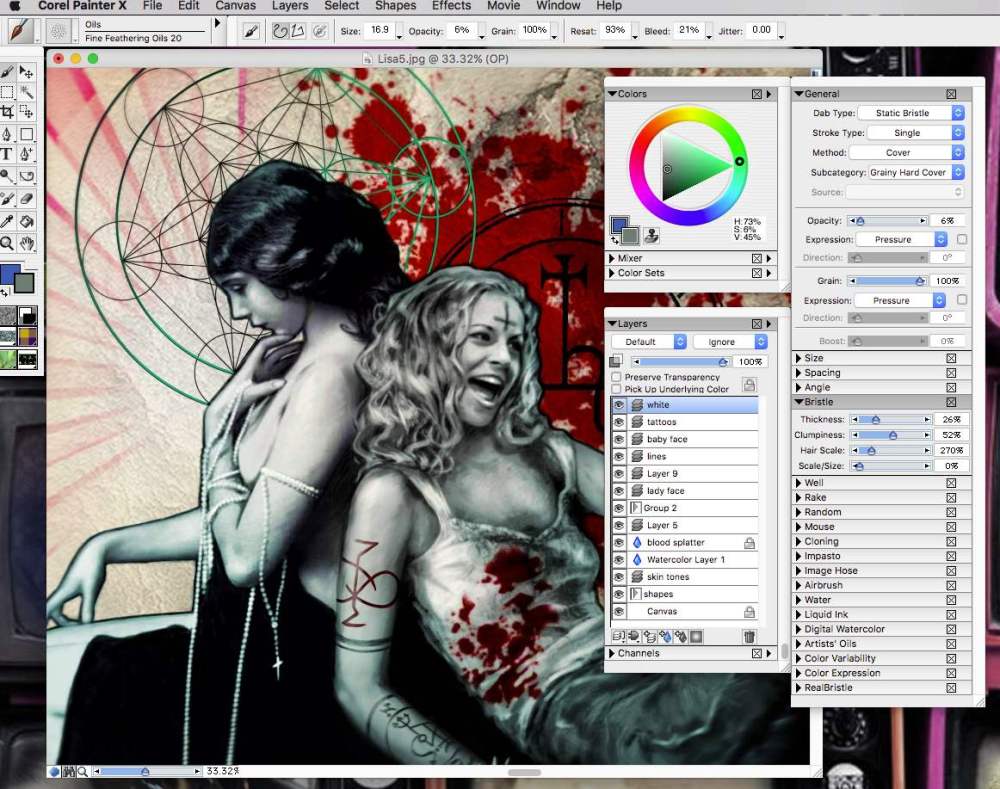This is one of the most frequent questions that I encounter as an artist. My skill level and style in both analogue and digital drawing and painting is more or less the same, and at times it is difficult for my audience to even tell the difference between something I drew by hand on paper and something I drew using a stylus in Corel Painter. Digital painting is one of my favorite ways of artistic expression, but it is often misunderstood.
The mystery revealed
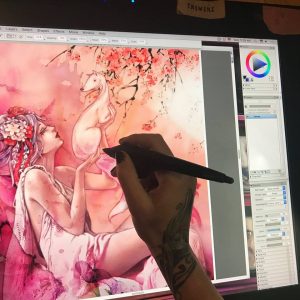 When people hear the word “digital” they automatically assume that a computer somehow generates the images for the artist. It is true that there are many forms of visual representation that can be created using digital technology. Purely computer generated graphics such as fractals, algorithmic art, scanned photographs, vectors, and 3D rendering all require great skill and talent to work with, but not all of them require an artist to be the driving force. An artist may provide a vector designer with a sketch for instance, but one is not required to know how to draw to use vectors, or do photo editing.
When people hear the word “digital” they automatically assume that a computer somehow generates the images for the artist. It is true that there are many forms of visual representation that can be created using digital technology. Purely computer generated graphics such as fractals, algorithmic art, scanned photographs, vectors, and 3D rendering all require great skill and talent to work with, but not all of them require an artist to be the driving force. An artist may provide a vector designer with a sketch for instance, but one is not required to know how to draw to use vectors, or do photo editing.
Digital painting is a very specific niche in the digital world. It is a method of creating art with the help of computer software that simulates actual drawing and painting. Modern painting software is capable of adopting to graphite, chalk, charcoal, acrylic paint, watercolor paint, oil paint, spray paint, etc.
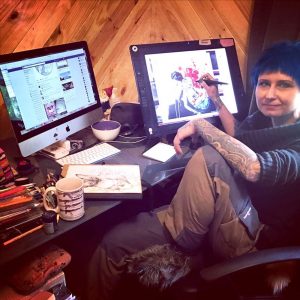 In my home studio I have, in addition to my computer, a 21″ Wacom drawing screen. I use a program called Corel Painter to sketch, draw and paint images that are in my head, the same way that I would do on paper. In this program I am equipped with a multitude of media and utensils simulators, but if that wasn’t enough I am also able to modify them or even create my own. For example, when I design a custom tattoo for a client, I use a “brush” that I’ve created with the same number of bristles as the number of needle points on the tattoo needle that I will use when actually applying the tattoo to skin. This way, I know that my design will be physically tattooable and will come out exactly the way that I drew it. When working with oil or acrylic paint simulations, I often create personalized brushes as well, to mimic the real life rigidity of the physical brushes I use on canvas.
In my home studio I have, in addition to my computer, a 21″ Wacom drawing screen. I use a program called Corel Painter to sketch, draw and paint images that are in my head, the same way that I would do on paper. In this program I am equipped with a multitude of media and utensils simulators, but if that wasn’t enough I am also able to modify them or even create my own. For example, when I design a custom tattoo for a client, I use a “brush” that I’ve created with the same number of bristles as the number of needle points on the tattoo needle that I will use when actually applying the tattoo to skin. This way, I know that my design will be physically tattooable and will come out exactly the way that I drew it. When working with oil or acrylic paint simulations, I often create personalized brushes as well, to mimic the real life rigidity of the physical brushes I use on canvas.
Benefits of digital vs analogue painting
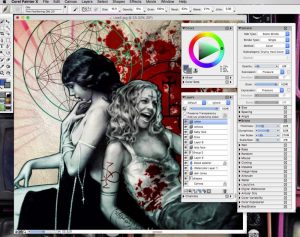 The obvious benefit of going digital is having unlimited art supplies and being able to create images of any size without leaving your desk. I can, for instance, create a giant oil painting without having to stretch the canvas, mix the paints, use the paints and have to buy more, work within a set time window while the paint is fresh and moist, and a number of other physical limitations. A digital painting setup is an investment. After the initial purchase cost, you never need to spend money on pens, pencils, paper, canvas, paints, pain thinners, etc. You are able to make volumes of drawings without needing to resupply. To me that’s magical.
The obvious benefit of going digital is having unlimited art supplies and being able to create images of any size without leaving your desk. I can, for instance, create a giant oil painting without having to stretch the canvas, mix the paints, use the paints and have to buy more, work within a set time window while the paint is fresh and moist, and a number of other physical limitations. A digital painting setup is an investment. After the initial purchase cost, you never need to spend money on pens, pencils, paper, canvas, paints, pain thinners, etc. You are able to make volumes of drawings without needing to resupply. To me that’s magical.
The fact that images are immediately in a digital form is also a great benefit in the modern world. When I was an art student in university, dragging about my 6-foot canvases, I had to rent a photo studio and equipment to take professional shots of my art work. Then I had to take the time to personally develop those photos. A digital image is automatically in high resolution. I have complete control of my color palette, lighting, size and level of detail. From the moment they are completed, my digital paintings are ready to be published online and in print.
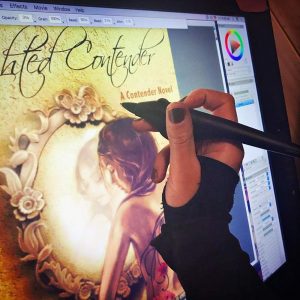 My favorite part about digital painting is the editing, specifically when working on a commission project with a client. Designing a book cover, for example, may take several drafts. I have to go back and forth with the author, tweaking details, or even making major changes before we settle on the final design. Had I been drawing or painting a cover by hand, I would have to recreate the image from scratch every time my client wished to see a change in lighting or a slightly different hair color on the character. That would be a horrific waste of time for both of us. Some edits would never get made because of this. Working digitally, on the other hand, allows me to make any change or adjustment immediately, without affecting the rest of the composition. Not to mention the fact that I can personally work on the printing layout and formatting, saving my client time and money and preventing them from having to hire a separate professional to do this.
My favorite part about digital painting is the editing, specifically when working on a commission project with a client. Designing a book cover, for example, may take several drafts. I have to go back and forth with the author, tweaking details, or even making major changes before we settle on the final design. Had I been drawing or painting a cover by hand, I would have to recreate the image from scratch every time my client wished to see a change in lighting or a slightly different hair color on the character. That would be a horrific waste of time for both of us. Some edits would never get made because of this. Working digitally, on the other hand, allows me to make any change or adjustment immediately, without affecting the rest of the composition. Not to mention the fact that I can personally work on the printing layout and formatting, saving my client time and money and preventing them from having to hire a separate professional to do this.
We live in a fast paced modern word. Classical art forms will never die or become obsolete, but they are becoming a luxury. A modern artist needs to adjust to styles, presentation, and accessibility of current demands.
